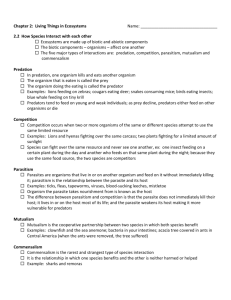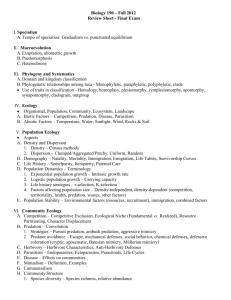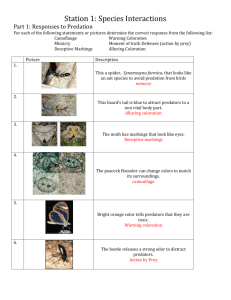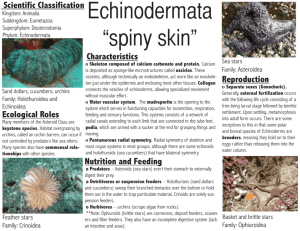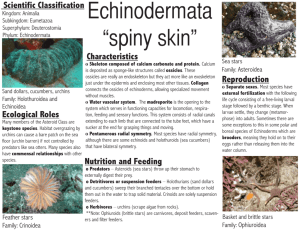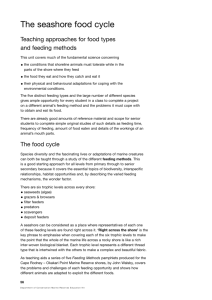Hand out - University of San Diego Home Pages
advertisement
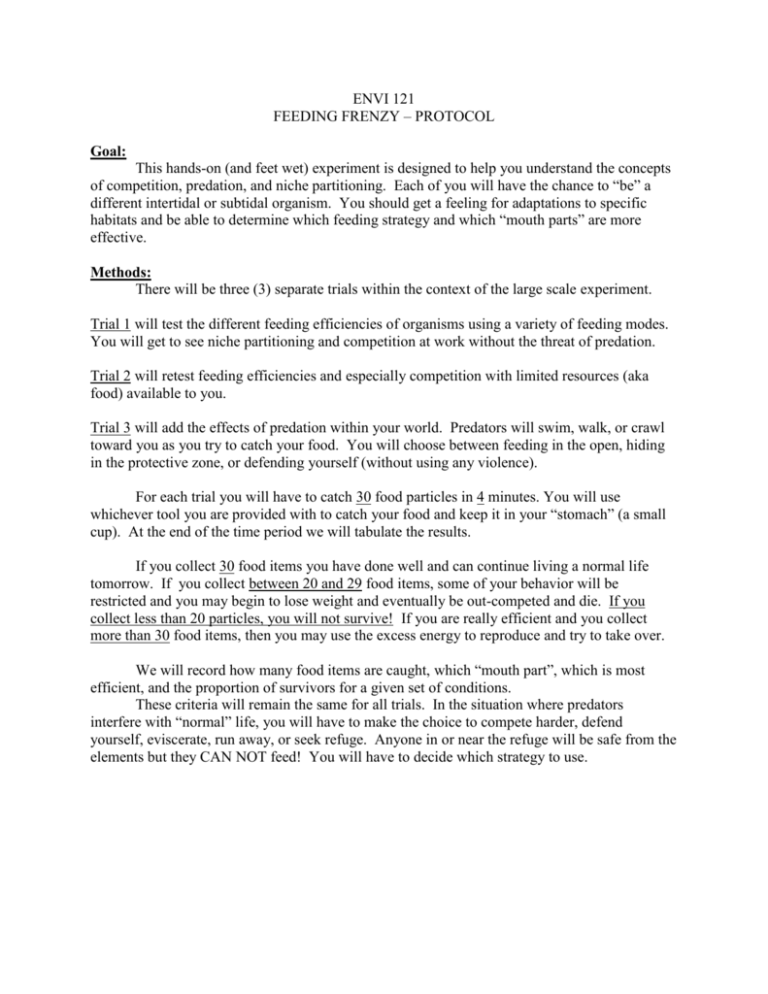
ENVI 121 FEEDING FRENZY – PROTOCOL Goal: This hands-on (and feet wet) experiment is designed to help you understand the concepts of competition, predation, and niche partitioning. Each of you will have the chance to “be” a different intertidal or subtidal organism. You should get a feeling for adaptations to specific habitats and be able to determine which feeding strategy and which “mouth parts” are more effective. Methods: There will be three (3) separate trials within the context of the large scale experiment. Trial 1 will test the different feeding efficiencies of organisms using a variety of feeding modes. You will get to see niche partitioning and competition at work without the threat of predation. Trial 2 will retest feeding efficiencies and especially competition with limited resources (aka food) available to you. Trial 3 will add the effects of predation within your world. Predators will swim, walk, or crawl toward you as you try to catch your food. You will choose between feeding in the open, hiding in the protective zone, or defending yourself (without using any violence). For each trial you will have to catch 30 food particles in 4 minutes. You will use whichever tool you are provided with to catch your food and keep it in your “stomach” (a small cup). At the end of the time period we will tabulate the results. If you collect 30 food items you have done well and can continue living a normal life tomorrow. If you collect between 20 and 29 food items, some of your behavior will be restricted and you may begin to lose weight and eventually be out-competed and die. If you collect less than 20 particles, you will not survive! If you are really efficient and you collect more than 30 food items, then you may use the excess energy to reproduce and try to take over. We will record how many food items are caught, which “mouth part”, which is most efficient, and the proportion of survivors for a given set of conditions. These criteria will remain the same for all trials. In the situation where predators interfere with “normal” life, you will have to make the choice to compete harder, defend yourself, eviscerate, run away, or seek refuge. Anyone in or near the refuge will be safe from the elements but they CAN NOT feed! You will have to decide which strategy to use. Lab report: Introduction -- should include background information on niche partitioning, feeding strategies of intertidal organisms (filter feeders, deposit feeders, scavengers, predators, etc.), definition of competition and predation. Be sure to include the purpose and your own hypothesis for this experiment. Methods – explain, in your own words, in detail everything we did for the three trials (be sure to include the point scale for survival, food points, times, utensils used, etc.) Results – include tables and figures with correct labeling, as well as written section explaining what happened in words. I suggest you give averages for the tables, and make a stacked bar chart of the % survivors vs. % deaths (you will receive instructions for this via email along with the raw data). Be specific, give actual values to demonstrate the trends you mention. Remember to look at ranges in values as well as averages. Discussion – analyze the experiment by trial, explaining which feeding styles were worst/best. Be sure to discuss why they were bad/good and what other factors might have affected how many points were earned. Discuss frequency of life/death and what factors assisted this, such as competition and predation. When discussing the points (success rates) you can include weird (very high or very low) numbers in the discussion that may have affected the averages that were reported in your results. For example, if two people used the same utensil and one person was a poor feeder while another one was very good, how does this affect results? Based on our results do we accept or reject our hypothesis? Make sure you support this statement from the data that we collected. This is the most important section of your entire report. Make sure you spend some time on it, making sense of all the data you are presenting. Also, be very detailed. Give the whats, whys, and hows of all the information you present. Conclusion – discuss errors in the experiment that could have affected our results. Also suggest ways to improve the experiment, if we were to repeat the experiment, what would you do differently? Why would you make that change to the protocol? What specific problem would that change address? Give lots of detail here as well. In your Lab Notebook: Include a one-page summary of your lab experience. Explain what happened to you as a feeder, which utensil you used, and tell me how competition and predation affected you directly. What do you think would have improved your experience?



